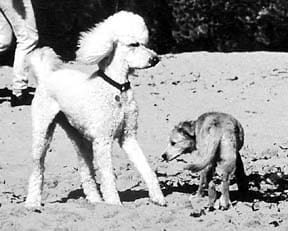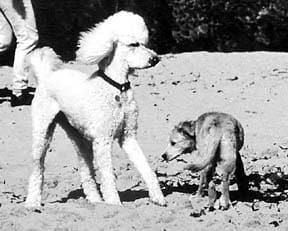[Updated November 8, 2017]
During the early morning hours, the lions brought down a large giraffe. Enjoying their good fortune, the several lionesses, their cubs and the two handsome males ate their fill. As the day advanced and the heat became oppressive, they stretched out in the shade keeping a watchful eye on the remains of their meal.
Nearby, a jackal, cousin to the wolf and the domestic dog, sat patiently eyeing the pride and the carcass, hoping for a snack. The jackal looked at the lions, then turned his head and looked away. Again he looked back and this time he yawned.
Was the jackal merely tired from waiting? No, he was using calming signals, the universal canine language of peace, to avoid raising the ire of the lions. The wild canids of Africa and our companion dogs here at home share the same complex language of gesture designed to keep things mellow. In the turn of a head, the blink of an eye, a lick of the nose or a yawn, a whole story unfolds in the canine lexicon.

Turid Rugaas, an inquisitive Norwegian dog trainer and patient observer of canine behavior, has identified 27 different gestures dogs use to communicate with each other, signs she has labeled calming signals. Dogs and other canines use such signals to send messages of non-aggression to other dogs and animals of all species including us. The calming signals are thought to help relax the communicators themselves, at the same time.
Dogs Communicate in Order to Cooperate
The earliest wolf researchers focused largely on the aggressive tendencies in their subjects. Terms like “alpha female” and “dominance and submission” quickly entered our vocabulary when speaking about the behavior of dogs. Those researchers also spoke of cut-off signals in wolves, body language designed to cut off signs of aggression. But Rugaas says calming signals do more than stop aggression; they are proactive communications to help foster cooperation.
Rugaas acknowledges that wolves are a communal species. They live in packs and therefore must have a complex language and social structure designed to foster group dynamics. Think of the skills we must develop to get along with just a single partner, never mind a complex extended family.
For wolves, the pack is necessary for survival. Food is essential and so is the hunt. To bring down a large prey animal takes tremendous cooperation among pack members. Developing and maintaining a language to keep the peace is as essential for wolf survival as is getting the next meal. Wolves and dogs have a strong instinct for conflict solving, communication and cooperation, all a necessary part of pack behavior. They must get along to survive.
Our domestic dogs share much of the same DNA as wolves. According to Rugaas, the most frightening thing for a dog is to be alone. While we can teach them to accept aloneness, we must remember that by nature they, too, need a pack to feel safe. Without other dogs in the home, we become their pack. Learning their language can foster maximum respect and cooperation; when in Rome, speak Italian!
How Dogs Learn Their Language
Pups who are raised in a litter for the first eight weeks of their lives (and in the presence of older dogs) have the advantage of learning skills from their siblings and elders. They learn to accept the leadership of a just leader. They learn simple, but crucially important lessons such as bite inhibition. They come to understand when play is too rough or inappropriate. And they have the opportunity to learn the language skills that will enable them to be peaceful pack members.
According to Rugaas, dogs inherited the calming signals from their wolf forbears. All the different breeds all over the world – no matter what size, color, or shape they are – display these signals. “It is a truly universal language and a wonderful one because it means we can communicate with dogs wherever we meet them,” says Rugaas.
“Canine language in general consists of a large variety of signals using body, face, ears, tail, sounds, movement, and expression. The dogs’ innate ability to signal is easily lost or reinforced through life’s experience,” she says. “When we remove pups from their litters too early, or when we keep them from other dogs, even to prevent early puppyhood diseases, we may be doing them a great disservice by depriving them of the chance to practice their own language.”
Dogs Use Calming Signals on YOU!
The most obvious signals used by dogs are the threat signals: Barking, hardening the eyes, and showing teeth are fairly easy to notice. Charging and snapping gets anyone’s attention. Biting is pretty tough to miss. But we usually overlook the equally important calming signals. Our dogs are always trying to communicate with us, but are we listening, or should I say looking? Say you have come home late from work, frustrated that you have to go out again to a meeting. Or maybe you just want to catch a movie to relax, but you only have 20 minutes to change clothes and leave again! You greet Sparky at the door. He, of course, showers you with affection and enthusiasm by jumping in your face, while telling you vocally how happy he is to see you. You let him out in the yard to do his business. He runs this way and that, checking up on the news of the day by sniffing the lawn and bushes. When he is done relieving himself, you call him to come in. You’ve checked your watch and you are now running late. There is a bit of urgency in your voice. “Sparky, come!”
But Sparky starts sniffing again, and annoyed, you call him once more. This time Sparky looks up at you, then turns his head to the side, licks his nose and starts coming toward the back door in what appears to be a roundabout way, a curved route if you ever saw one. And he slows down.
You may be sure he’s just trying to make you late, but you are mistaken. Sparky has just made five attempts to calm you down: sniffing, turning his head, licking his nose, advancing in a curved line, and moving slowly. He has heard your irritation and knows something is amiss. He’s offering his best attempt to help you stay cool.
Let’s look at a few of the calming signals and expand our vocabulary.
• Sniffing
Of course, dogs sniff to sniff smells. But your dog may do it when another dog is approaching her, when someone is walking straight at her, or when a sudden situation occurs – for instance two dogs are suddenly too close. Or if you call your dog to you in a harsh voice or from a full front position. Face-to-face, eye-to-eye posture to a dog can be construed as somewhat aggressive or dangerous, so some calming down may be in order.
A very dog-aggressive Rottweiler I once worked with would root like a pig, sniffing furiously, when she first saw a dog approaching from a distance. Without understanding her need to send a calming message to the intruder, her owner, tugging on the leash, would deprive the dog of her “peace-maker’s voice.” Fearful of other dogs, the Rottie would then lunge like a barking fury to tell the perceived adversary to stay away.
• Turning the head
All signals may be quick movements or, as here, the head can be held to the side for some time. It may be as small as a looking away of the eyes or may involve turning the whole body away.
Your dog may turn her head to the side when a stranger approaches or a child offers an inappropriate hug. When two dogs meet, they may both look away for a second, and then greet each other happily. A self-assured dog may approach your dog very directly, but averting his eyes from side to side, sending the message that he is a friendly fellow. Your dog may lick her nose, turn her head to the side and be ready for a big hello.
This is a signal we can use to help greet scared, shy, or aggressive-behaving dogs. By approaching a new dog at an oblique angle and looking away, we can send the message that we are friend, not foe.
• Licking the nose
This can be a very quick movement of the tongue that is difficult to see, or it may be a clean swipe of the nose. Your dog may use it when being approached by another dog, or when you bend over your dog or make him uncomfortable in some way. Black dogs, whose facial features are not as easy to see from a distance, may use the licking signal more often.
Rugaas says it is a difficult one for people to use, but I use it having assumed that by licking my lips, though not actually getting to my nose, I’m “speaking” an understandable dialect.
• Yawning
This is a signal easily used by humans. It was the one chosen by our jackal to speak to lions. Your dog may yawn when at the veterinarian’s office or when being approached by a stranger. You may use it when your dog is a bit stressed, worried, scared, or when you want him to calm down. I have watched dogs look up at me in apparent amazement when they see me yawn and realize I am speaking their language.
Other signals include walking slowly or using slow movements, sitting down, lying down or using a stretch-in-place or the play bow. Walking in a curved line, lifting the paw, twirling around each other and blinking the eyes are also calming signals.
Teaching Your Dog Calming Signals
Rugaas employs her knowledge of these signals when introducing two dog-aggressive or shy dogs. With each dog on leash, she has their handlers approach from a distance allowing each animal to sniff, look away, lick or yawn as it chooses. By monitoring their reactions, she orchestrates the meeting, keeping the anxiety level low.
She does the same when introducing a shy dog to a new person. She may have the person approach in a curve, walking slowly, looking away and even sitting on the ground. By gauging the dog’s reaction she knows when it’s safe to let the dog come over to greet the person. Sometimes it may take more than one session.
By sharpening our powers of observation, we can begin our own adventure of exploration with our canine companions and assist them at the same time.
Boosting Interspecies Communication
I recently helped introduce a cat and dog who had to share a new house with each other. The cat was very self-assured and knew how to hold her own. The dog had lived and even slept with a cat before. The dog had great communication skills. My role became that of mediator. We handled the introductions slowly, observing the dialogue that took place between our two charges.
The cat was placed on the people bed in the dog’s room, while the dog was out of sight on the porch. As Elise, the cat, became comfortable, we brought Tucker, the dog, to the glass door. He cautiously looked away and licked his nose. The cat took the opportunity to study the dog, then she looked away, blinking her eyes. The dog now looked at the cat and looked away again.
Next, we brought Tucker into the room at a distance, and the dialogue continued. As they seemed to get more comfortable with each other, the dog yawned, then looked away once more. If Tucker looked a little too long at Elise, I called his name getting him to look at me and away from her. I had him sit, lie down and come to me, offering him food treats as incentive and reward, giving Elise the chance to see him in action.
By the end of the hour session, Tucker and Elise had both had a chance to observe each other in close proximity while feeling safe. The cat’s person had petted the dog, and the dog’s person had held the cat on his lap. The animals could see that each wanted to cooperate. We ended by allowing Elise to leave in her own good time. She hopped off the bed looking away from Tucker and slowly walked out the open door. Outside she licked herself, apparently pleased by the outcome. Tucker was equally happy and relaxed.
The next time you go to the dog park bring along your understanding of calming signals and check out the action. As you sharpen your observation skills, a whole new world will open before your eyes, and soon you, too, can get on talking terms with dogs. And while you’re at it, pay attention to your response when people make eye contact with you. Do you avert your eyes, walk across the street or flicker a brief smile? Maybe you already know more about calming signals than you think.
Author Jodi Frediani has spent a lifetime working with animals of all kinds. She is a Certified TTOUCH Companion Animal Instructor and TTEAM Horse Practitioner. She attended her first dog obedience classes at age 12, has been involved with TTEAM/TTOUCH since 1985 and currently teaches clinics in the United States and Africa.





